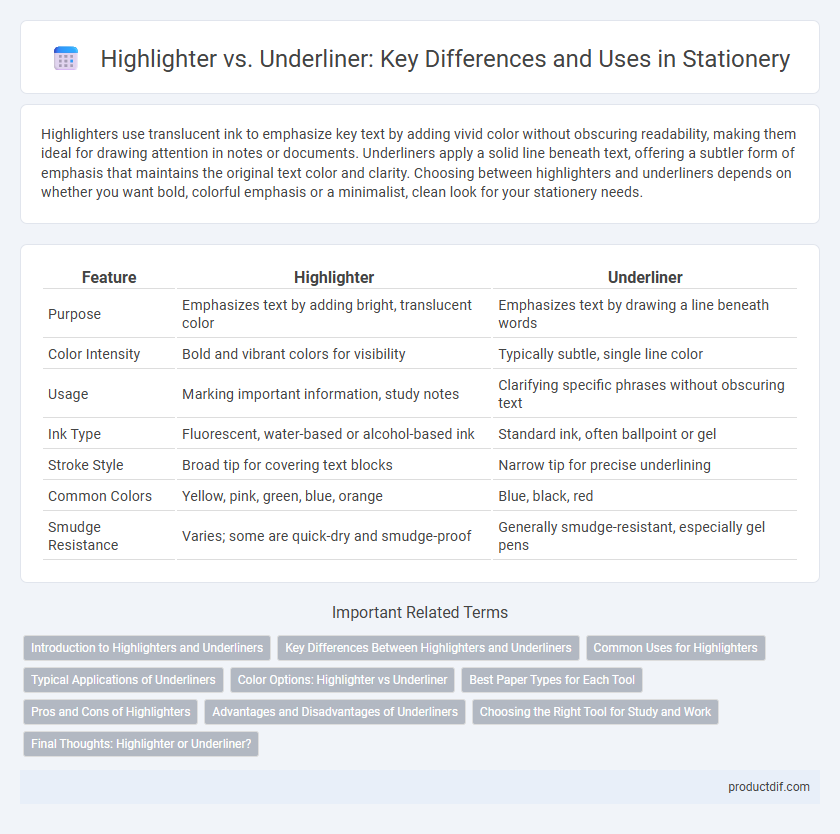Highlighters use translucent ink to emphasize key text by adding vivid color without obscuring readability, making them ideal for drawing attention in notes or documents. Underliners apply a solid line beneath text, offering a subtler form of emphasis that maintains the original text color and clarity. Choosing between highlighters and underliners depends on whether you want bold, colorful emphasis or a minimalist, clean look for your stationery needs.
Table of Comparison
| Feature | Highlighter | Underliner |
|---|---|---|
| Purpose | Emphasizes text by adding bright, translucent color | Emphasizes text by drawing a line beneath words |
| Color Intensity | Bold and vibrant colors for visibility | Typically subtle, single line color |
| Usage | Marking important information, study notes | Clarifying specific phrases without obscuring text |
| Ink Type | Fluorescent, water-based or alcohol-based ink | Standard ink, often ballpoint or gel |
| Stroke Style | Broad tip for covering text blocks | Narrow tip for precise underlining |
| Common Colors | Yellow, pink, green, blue, orange | Blue, black, red |
| Smudge Resistance | Varies; some are quick-dry and smudge-proof | Generally smudge-resistant, especially gel pens |
Introduction to Highlighters and Underliners
Highlighters are fluorescent markers designed to emphasize important text by adding vibrant, translucent color, improving readability and retention. Underliners, often slimmer and less vivid, create subtle emphasis by drawing a line beneath key words or phrases without obscuring the original text. Both tools serve distinct roles in organizing information visually during study or work.
Key Differences Between Highlighters and Underliners
Highlighters use fluorescent ink to emphasize text by adding bright, eye-catching color, while underliners typically employ dark, solid lines to draw attention without altering the background color. Highlighters allow quick scanning of important sections with vibrant hues, whereas underliners provide precise, subtle emphasis ideal for neat note-taking or professional documents. The choice depends on whether visual prominence or clean, minimal annotation is preferred for organizing information.
Common Uses for Highlighters
Highlighters are commonly used to emphasize important text in books, notes, and documents, making key information stand out for easier review. They are essential tools in academic and professional settings for quick identification of critical data, deadlines, or key points. Unlike underliners, which create subtle emphasis, highlighters provide vivid, fluorescent color that immediately draws attention.
Typical Applications of Underliners
Underliners are primarily used for subtle emphasis in professional documents, allowing readers to quickly identify key points without overwhelming the text. Their fine, consistent lines are ideal for annotating reports, legal documents, and academic papers where clarity and neatness are crucial. Unlike highlighters, underliners provide precision and maintain document readability while guiding attention effectively.
Color Options: Highlighter vs Underliner
Highlighters come in a wide range of vibrant colors such as neon yellow, pink, green, orange, and blue, designed to make text stand out prominently on the page. Underliners typically offer more subdued color options including pastel shades and classic hues like gray, navy, and soft pink, catering to more subtle emphasis needs. The color intensity of highlighters is generally brighter and more fluorescent compared to the softer tones available in underliners, making each suited for different highlighting purposes.
Best Paper Types for Each Tool
Highlighters perform best on smooth, non-coated paper types like standard office printer paper or lightweight notebook paper, where the ink absorbs quickly without bleeding through. Underliners are ideal for high-quality, thick paper such as premium journal or archival paper that prevents feathering and allows for sharp, precise lines. Using fountain or gel pen-friendly paper enhances the effectiveness of underliners by maintaining clarity and preventing smudging.
Pros and Cons of Highlighters
Highlighters offer vibrant, fluorescent colors that enhance text visibility and facilitate quick referencing, making them ideal for study and note-taking. However, highlighters may bleed through thin paper, causing smudging or distracting back-page markings, and their intense coloration can sometimes overshadow important details. Unlike underliners, highlighters cover entire text areas, which can either improve emphasis or reduce readability depending on usage and paper quality.
Advantages and Disadvantages of Underliners
Underliners provide a clear, distinct way to emphasize text without obscuring the original content, making them ideal for detailed note-taking and study. They tend to produce less eye strain compared to highlighters, as they use thin lines rather than broad strokes, but their precision can slow down the marking process. However, underliners may be less visible at a glance, reducing their effectiveness for quickly locating key points.
Choosing the Right Tool for Study and Work
Highlighters are designed with bright, translucent ink to emphasize key information, making them ideal for quick reference and visual organization in notes and textbooks. Underliners feature fine, precise tips that allow for neat, controlled marking beneath text, perfect for detailed study and professional documents. Selecting between a highlighter and underliner depends on the need for bold emphasis or subtle annotation tailored to study habits and work requirements.
Final Thoughts: Highlighter or Underliner?
Highlighters emphasize key information with bright, vibrant colors that enhance readability and retention, making them ideal for quick reference. Underliners provide subtle emphasis by neatly drawing attention to specific phrases or sentences without overwhelming the text. Choosing between a highlighter or underliner depends on whether you prefer bold visual cues or a more discreet, organized approach to note-taking.
Highlighter vs Underliner Infographic

 productdif.com
productdif.com